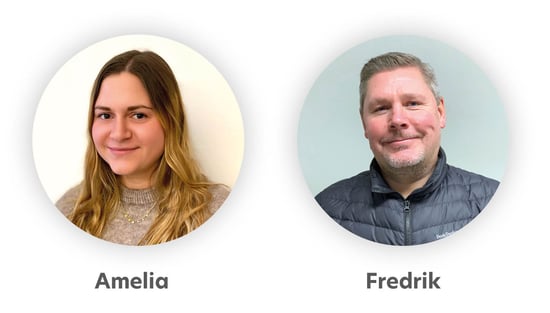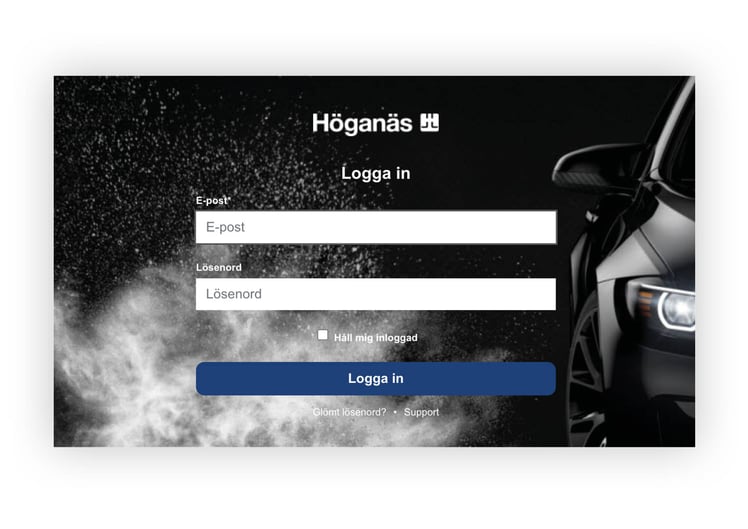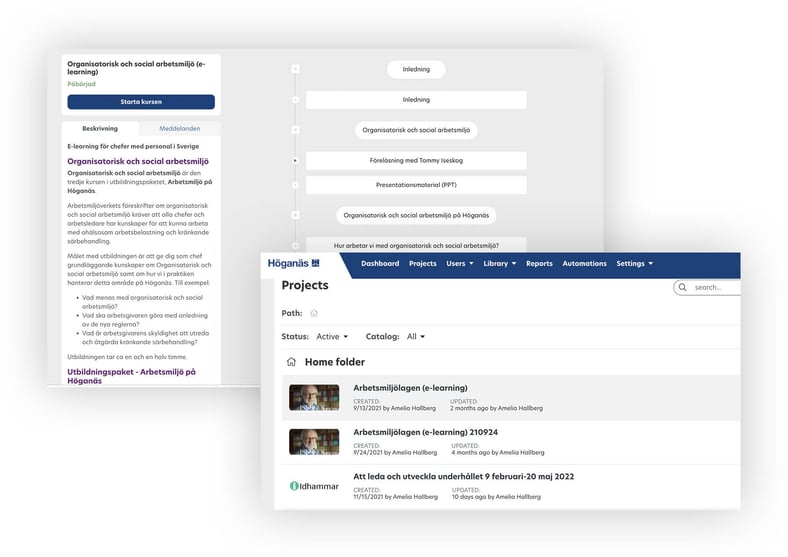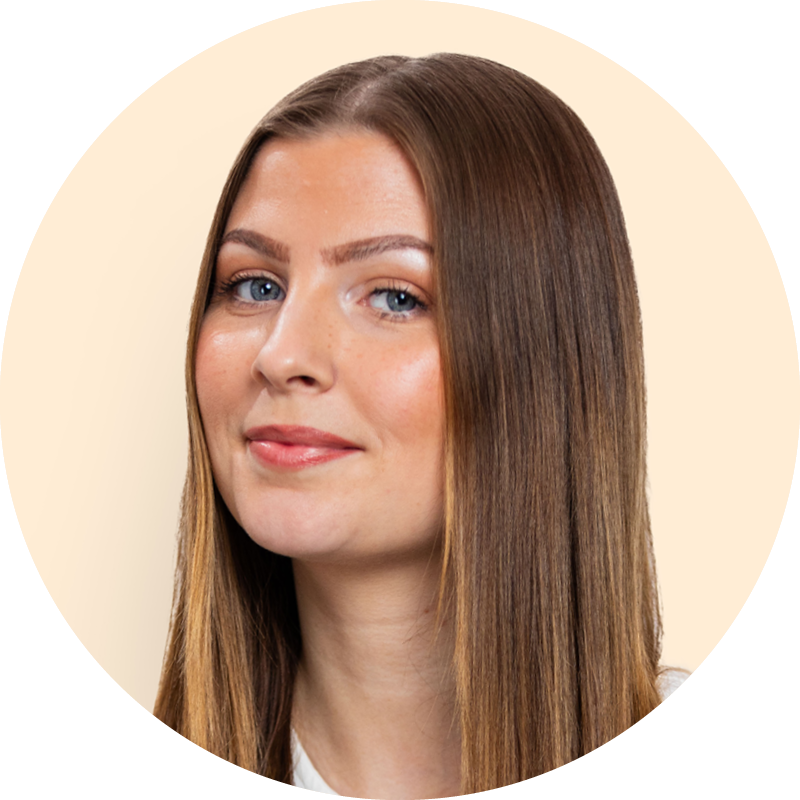Swedish company Höganäs is a world leader in the iron and metal powder market. Today, they account for as much as 40% of the total global market. Together with their customers, they develop the vehicle components solutions of tomorrow, high-temperature soldering, electric motors, additive manufacturing, and water purification. The company has about 2400 employees spread across 16 countries.
Höganäs has in a very short time come a long way with its digital competence development. We talked to their HR Director Fredrik Heidenholm and their HR Coordinator Amelia Hallberg who oversee the venture.
Take part in their work methods and get their best learnings and tips from the journey!

Tell us about yourself Fredrik!
What is your role at Höganäs?
- I have worked with HR for almost 25 years in various companies. Today, I am HR director at Höganäs. In addition to leading the HR department in Sweden, I am also part of the global HR management team. In my role, I support leaders and develop HR. Right now, we focus on digitization, simplification, and improvement.
And Amelia, same question to you!
- I work as an HR Coordinator and support Swedish managers with personnel responsibilities. I coordinate and own the competence and learning process at Höganäs. This means that I also run the competence work in our HR system, SDWorx. Learnifier and SDWorx work together and the systems are interconnected. I spend a lot of time with our learning platform Learnifier, book employees for various trainings, take care of course administration, and create our own e-learnings.
How many are you at HR?
Amelia:
- We are three HR Business Partners, one HR Coordinator, a Payroll Manager, three Payroll Administrators, and three people responsible for occupational health care.
What are the best parts about your jobs?
Amelia:
- I think the best part is to support and help the leaders and get feedback that we in fact simplify their daily work. The collaboration with the fantastic colleagues in the HR team is also great – that we can be creative and help each other to digitize and streamline our processes.
Fredrik:
- When you help managers succeed, when you find solutions to problems that simplify everyday life – that's probably the most rewarding part for me. Problem-solving.
"Right now, there is a great focus on managers – to establish management training in, for example, work environment as well as statutory and necessary training of various kinds."
What is the greatest challenge?
Fredrik:
- Time is a big challenge. We want to do a lot, but of course, the organization is busy. The business always comes first. The big challenge is to get access to the organization and improve things. It takes time as we all have a high workload. Sweden is also a challenge as we are a matrix organization, which adds complexity. We have many contact points in the matrix and no real Swedish CEO, but several managers who have the ultimate responsibility within their part in the matrix.
Amelia:
- I second that. We are also a new HR department so we need to build relationships and get to know how everything works in order to deliver good and relevant training. Which takes time.

Let's talk about onboarding and skills development. You work with a learning platform to share knowledge. Who are you communicating knowledge to via the platform and what courses do you have there?
Fredrik:
- We target both white-collar and collective employees.
Right now, there is a great focus on managers – to establish management training in, for example, work environment as well as statutory and necessary training of various kinds.
We have digitized our introduction and are in the process of building our course catalog. We also use Learnifier for our daily course administration where we try to automate as many functions as possible. There is an interest in the organization to use Learnifier for local and department-specific training and instruction. This is an area we will start looking into.
How did you choose your learning platform?
Fredrik:
- We upgraded SDWorx (formerly ADITRO), our HR system, in the spring of 2021, and Learnifier's platform was part of the package. It's great to have this integration, where the systems talk to each other. This makes our educational work easier.
Are your trainings mandatory?
Amelia:
- Most are not. Courses that are to lead to a certificate are of course mandatory, as are the introductions and some work environment training.
We are also in the process of creating educational programs for individuals to go through.

"We already have users in the organization who are themselves admins and can create their own courses and their own educational content. Of course, we help them out.”
How was this knowledge conveyed and how did you work with education before your current platform was in place?
Fredrik:
- We've had a different platform but are now winding it down. It was mostly focused on traditional classroom training and it was not possible to create your own e-learning.
How has the pandemic affected you?
Fredrik:
- It accelerated digitization. E-learning became more acceptable and the implementation was easier with the pandemic. But even before that, we had plans to digitize our training activities.
How do you set up your courses in terms of format? For example, what does a course in leadership training look like?
Fredrik:
- Most are self-study. There is a training package for managers and parts of the organization have also started to build up their own self-study. We have talked about having complementary live meet-ups as well. For the knowledge to sink in, we believe that it is important to be able to discuss with each other and share approaches in different situations.
Amelia:
- The digital introduction for managers, separate from the regular introduction, is today completely digital. But in the future, we also want to have opportunities where the managers can meet HR physically. Maybe four times a year. We strongly believe in the combination of physical and digital.
“The new Team View feature in Learnifier has been very good for us. Now the managers can see their teams, register employees for courses, and get an overview of how things are going."
How did you create your courses?
Fredrik:
- So far, HR has created the courses. But we talk a lot about this being the company's tool. We already have users in the organization who are themselves admins and can create their own courses and their own educational content. Of course, we help them out. To make learning interesting is an art.
Today, we are mainly working with text and images. But going forward we also want to work more with video and audio. There is development potential here. As people learn in different ways, we would like to be able to deliver the same content in different formats. Someone may learn best from images and text, someone else from listening, etc.
We also integrate external courses – created by others – with our platform. For example, we have a collaboration with Teknikutbildarna. As a participant, however, you start up and finish in Learnifier. The user experience should only be in Learnifier.
How do you measure success?
Fredrik:
- It's a hard question. Our work with systematic skills development is a journey for us. Our focus is now on getting the managers to work based on our processes in four steps:
Requirements – analysis – implementation – follow-up.
We try to work with the job profiles we have in our system. That the managers work actively with analysis and develop their employees and the level of competence in the department and thus the company.
To follow up and apply the knowledge in close connection to the course, are also important. Of course, we look at feedback from the participants to maintain quality. There we have a questionnaire for e-learning and one for classroom training.
“We want to be able to give managers the freedom to work in the system, sign their employees up for courses and give them insight into how things are going.”
How do they take in the knowledge? Via computer? Mobile?
Fredrik:
- Currently, via workplace computers. After all, we are a classic mill ...
We want everyone to be able to have access to the computers that are out in production. We are working on solving the technical part, as everyone should have a place where they can sit in peace and quiet. They need to be able to schedule their time when they focus on development. In the long run, we see that mobile phones will be a useful tool.
What is the next step for you regarding learning?
Fredrik:
- Focus has been on training and competence – to get the whole education and skills development process started and to create order and structure. To get managers to think about how they should work with our process and our tools. How to get all this in place. We have workshops with our managers to implement and decide what should be mandatory and not, how courses should be followed up, etc.
In the long run, we want managers to be able to plan when training is best suited for the sake of the business and for them to receive valuable follow-up. We also want to give them time to plan to keep track of certificates and vouchers that need to be taken or renewed. And the freedom to work in the system, sign their employees up for courses and give them insight into how things are going.
Through our HR system and our learning platform, we also want to be able to set requirements and make analyzes at different levels: Individual, team, department, and/or even at company level.
“Think ahead and start small! Everything doesn't have to be 100% clear. You can add and adjust."
What are your main tips and lessons from your journey of creating digital competence development? What would you say to someone who was just getting started?
Amelia och Fredrik:
– Dare to experiment!
– Allow yourself time. Getting written material right, working on video clips, etc. takes longer than you think!
– Try to use existing material in smart ways, like by inserting PPT images, etc.
– Keep it short and sweet. Text easily becomes too much information. Instead, divide the content into several pages (activities in Learnifier).
– As a person in charge, you need to define a clear purpose of the course. What are the different steps? Your learning platform should support the process but you need to have a plan. Think ahead and start small! Everything doesn't have to be 100% clear. You can add and adjust.
– The new Team View function in Learnifier has been very good for us. Now, the managers can see their teams, register employees for courses, and get an overview of how things are going. This is a great function as we want the managers to easily be involved in their teams' skills development.
– It should be the company's and not HR's tool. Many leaders now build their own courses in Learnifier instead of using programs like Powerpoint.
– Purchase external courses and link them with your learning platform. You don't have to do everything yourself!
Interview by: Rebecca Cannerfelt
_______________
Would you like to experience the learning platform Höganäs use for their onboarding and training?
Over 300 companies and organizations around
the world work with Learnifier for their onboardings, training and skills development. Find out why!
Read more, book a meeting or trying our tool for free
.png?width=153&height=58&name=Learnifier%20TextLogo%20NearBlack%20-%20PNG%20MEDIUM%20-%20800px%20(2).png)





